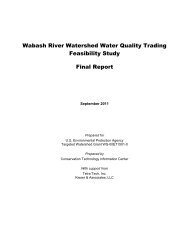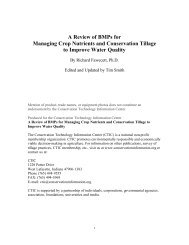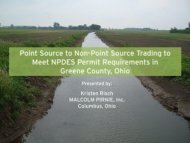Facilitating Conservation Farming Practices and Enhancing ...
Facilitating Conservation Farming Practices and Enhancing ...
Facilitating Conservation Farming Practices and Enhancing ...
Create successful ePaper yourself
Turn your PDF publications into a flip-book with our unique Google optimized e-Paper software.
6<br />
U.S. Soybean Acres <strong>and</strong> Yield<br />
Acres (millions)<br />
Bushel per acre<br />
80<br />
70<br />
60<br />
50<br />
40<br />
30<br />
20<br />
10<br />
0<br />
Planted Yield<br />
50<br />
45<br />
40<br />
35<br />
30<br />
25<br />
20<br />
1980 1985 1990 1995 2000 2005 2010 2015<br />
Year<br />
Source: USDA Agricultural Baseline Projections to 2016 (USDA ERS, 2007). USDA, Economic Research Service.<br />
The Next Generation<br />
of Biotech Crops<br />
The direct benefits of the first generation of biotechnology-derived<br />
crops lay largely in production efficiencies – easier, more effective pest<br />
control. Part of the reason is that introducing a gene that produces a<br />
single protein is much simpler than transforming a crop with multiple<br />
genes to address more complex challenges such as nutrient content<br />
or stress tolerance.<br />
Ironically, the success of the first generation of biotech crops fueled<br />
some opposition to plant biotechnology. Though the rapid embrace<br />
of biotechnology by the pharmaceutical industry – where it was harnessed<br />
to design, improve <strong>and</strong> produce a variety of medicines, including<br />
insulin – raised little or no consumer suspicion, biotech crops have<br />
stimulated heated public debate in many areas.<br />
As a result, the commercial release of some biotech crops has been<br />
challenged, <strong>and</strong> sometimes delayed. In some cases, the impetus came<br />
from consumers, such as the 2009 lawsuit – the second year Roundup<br />
Ready sugar beets were planted commercially – in which a U.S. District<br />
Court judge ruled that Monsanto had to complete an environmental<br />
impact statement on the crop (Pollack, 2009). In other cases, such as<br />
with bioengineered wheat <strong>and</strong> potatoes, many farmers <strong>and</strong> large food<br />
retailers resisted the commercialization of the crops, afraid that frightened<br />
consumers, especially in export markets, would close their doors<br />
on biotech staples.<br />
Much of the anti-biotech debate highlights the fact that some shoppers<br />
are wary of input traits that benefit farmers without a direct payoff<br />
for consumers. Also, they may not consider indirect benefits such as<br />
lower food prices, less use of crop protection products <strong>and</strong> better conservation<br />
practices that protect soil, water <strong>and</strong> air resources. However,<br />
a new wave of biotech crops may offer consumers more benefits to<br />
which they can relate directly.<br />
The next generation of biotechnology will be focused<br />
on output traits, or consumer attributes, including:<br />
• Soybeans whose oil contains less linolenic<br />
acid <strong>and</strong> more oleic acid, which improves<br />
heat stability without producing trans fats<br />
that have been implicated in coronary disease;<br />
• Soybeans with lower levels of saturated fat<br />
<strong>and</strong> high levels of unsaturated oleic acid, for<br />
a health profile akin to olive oil;<br />
• Soybeans high in heart-healthy Omega 3 fatty<br />
acids, such as stearidonic acid;<br />
• Food ingredients in which the major allergens<br />
are modified or eliminated;<br />
• “Golden rice,” which produces beta-carotene in its endosperm.<br />
Beta-carotene, the carotenoid that stimulates the production<br />
of Vitamin A, is typically produced in the green tissues of riceplants,<br />
but is ordinarily not consumed (Golden Rice Humanitarian Board,<br />
2009). Vitamin A deficiency blinds more than 500,000 children <strong>and</strong><br />
kills more than 2 million people per year, according to the World<br />
Health Organization (Dobson, 2000);<br />
• Crops that can be converted more efficiently into biofuels, such as<br />
readily fermentable corn.<br />
Additional input traits are also being developed or commercially introduced,<br />
including:<br />
• High-yielding soybeans capable of 7-to-11-percent increases in<br />
yield potential;








